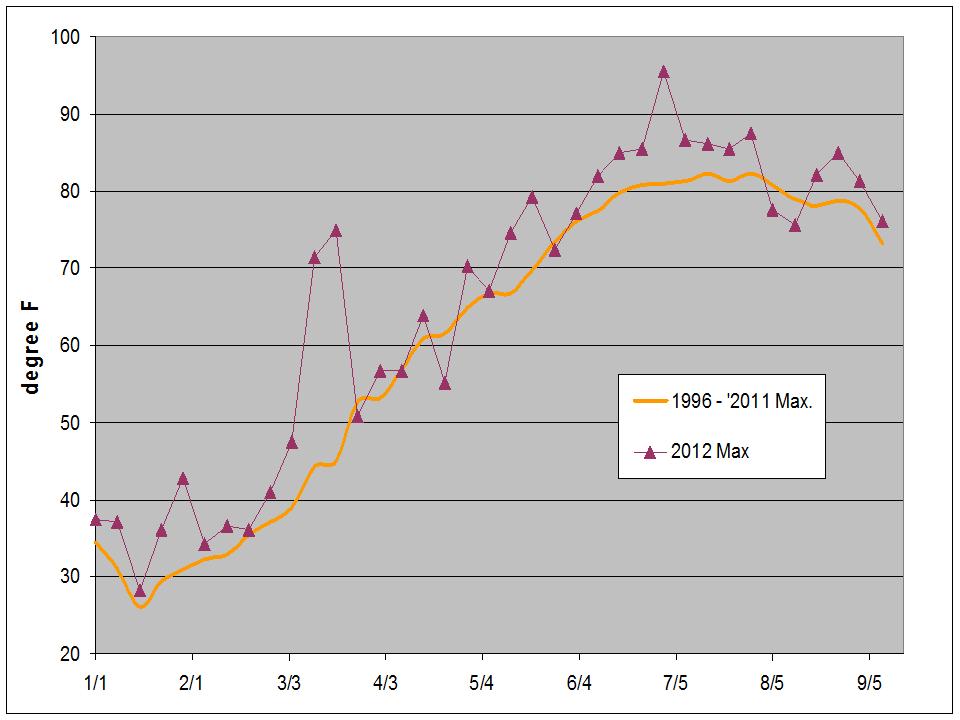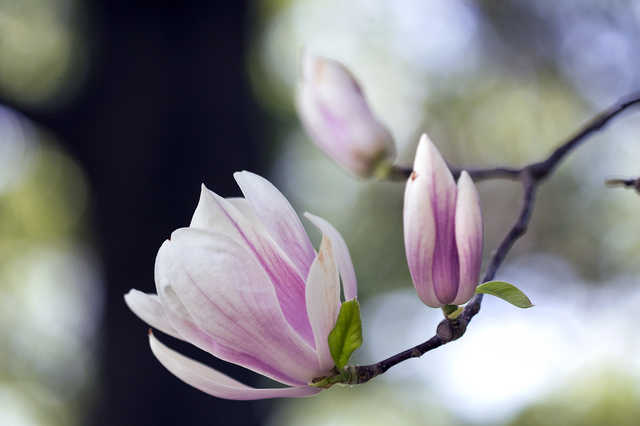It seems like every year we end up talking about ‘weird’ weather; either it’s extreme heat, extreme cold, too much rain, not enough rain, and on and on. Here in the upper Midwest and other parts of the central US, however, 2012 is clearly a year to remember. Our winter was fairly unremarkable until we hit 8 days over 75 deg. in mid-March. This pushed our growing degree days up at least 3 weeks and set the stage for widespread late-freeze damage in April, wiping out the state’s cherry, peach, and plum crops. Summer turned out warm and dry, highlighted by record-setting heat in July.

Weekly average high temperatures from MSU Hort Farm weather station: 2012 versus average of 15 previous years.
Now that we’ve seen some relief from summer’s drought and heat, we’re experiencing one more weather-related phenomenon: stress flowering. At my place I had lilacs and azaleas start to flower in August. We have also had reports of crabapples flowering in the eastern part of the state. Trolling around the web, I ran across a photo of magnolias blooming this month in Kansas City.

Magnolia flowering in mid-September. Source: Kansas City Star
So, what’s going on? Severe heat and drought can cause plants to go into a state of eco-dormancy. Typically we define “true” dormancy as a state where plants won’t grow, even when environmental conditions are favorable. Eco-dormancy represent the flip-side; plants should be growing but can’t due to severe environmental stress. In some cases the stress can induce flowering, such as we’ve seen this year. We have also seen examples of trees that have re-flushed, sending our new leaves after shedding leaves during the peak of the drought.
Will any of this cause long-term problems for trees and shrubs? Probably not. Stress flowing tends to be sporadic so most flower buds on a tree or shrub are likely to be unaffected. Shoots that re-flush late in the summer may or may not be able to harden off before winter. If not, they will be subject to freeze injury just like shoots that flushed earlier the spring. The main concern for 2012 is the cumulative toll of our environmental extremes.
Our saucer magnolia bloomed after the horrible heat was over and I’ve never seen it do that before. We’ve had several perennials flower out of season also, again never seen it this time of year. Now that I’m aware (thanks to your post) I’ll look for more signs.
Sandy, if you (or other readers) have a chance to forward some photos of stress flowering to my e-mail cregg@msu.edu, that wold be great.
Just a quick aside to those that tried to comment earlier on this post but couldn’t. Linda, who dutifully takes care of all the administrative chores on the blog, discovered yet another quirk of the system. If a post title starts with a number (my original title was “2012: The wackiness continues”), then the post can’t be linked or commented on. My apologies to anyone that tried to comment before Linda made the fix.
Believe it or not I’m seeing the same thing over here with apples, Magnolias and numerous other bushes and berry producing shrubs which are loaded with berries, but they are starting to flower again. Incredibly it is not that warm and it’s been consistently wet all from late spring to the present l
ight rain outside my home now. Our blooms this year didn’t happen till late May in Göteborg Sweden and not much fruit at all was experienced. The deciduous shrubs and trees were attacked by all manner of mildews and other blight and insects and that is something I never ever have seen in the wild. Very bizarre. Definitely some type of global phenomena.
My Syringa x lacinata is just starting to reflower and my Syringa pekinensis has already. I’ve also noticed a Syringa chinensis blooming at work. I’m in the Chicago suburbs, and we’ve also seen some sporadic crabapple re-bloom.